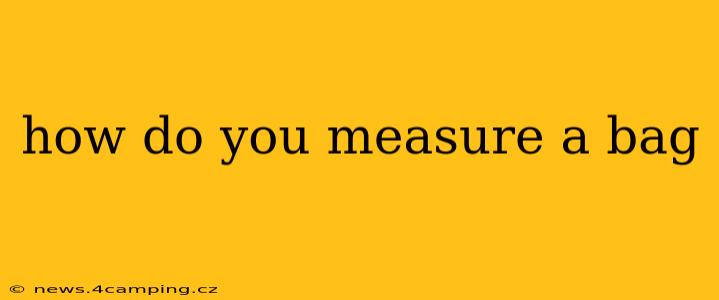Measuring a bag accurately is crucial for various reasons, from ensuring it fits your needs and desired items to confirming compatibility with airline carry-on restrictions or finding replacement parts. The process depends on the type of bag and what you need to know. This guide covers everything you need to understand bag measurements and how to take them effectively.
What are the Standard Measurements for Bags?
The standard measurements for bags typically include length, width, and height. These dimensions are usually expressed in inches or centimeters. Some bags, particularly luggage, might also specify a depth or a total linear dimension (TLD), which is the sum of the length, width, and height. Understanding these dimensions is fundamental to accurate bag measurement.
How to Measure a Handbag or Purse?
Measuring a handbag or purse is usually straightforward. Use a flexible tape measure and follow these steps:
- Lay the bag flat on a surface: Ensure the bag is open and lying flat to get the most accurate measurements.
- Measure the length: Measure the longest side of the bag from one end to the other.
- Measure the width: Measure the shortest side of the bag, perpendicular to the length.
- Measure the height: Measure from the base of the bag to the highest point, usually the top.
- Note the measurements: Record your measurements in inches or centimeters. It's helpful to note the units you used.
How to Measure a Backpack or Travel Bag?
Backpacks and travel bags require a slightly different approach:
- Stand the bag upright: Place the bag upright on a flat surface.
- Measure the height: Measure from the base of the bag to the top.
- Measure the width: Measure the widest part of the bag across.
- Measure the depth: Measure the bag from front to back at its widest point. This is often the most crucial dimension for determining if items will fit.
- Record measurements: Again, note the units used (inches or centimeters).
How to Measure Luggage?
Luggage measurements are vital, especially when considering airline carry-on restrictions. Airlines have specific size limits. Therefore, precise measurements are critical to avoid fees or having your luggage rejected at the gate.
- Use a rigid measuring tape: A flexible tape measure might not provide as accurate results for luggage.
- Measure the length, width, and height: These dimensions are typically the key measurements for airline baggage restrictions. Be sure to include any wheels or handles in your measurements. Remember to measure the bag's overall dimensions, including any external pockets or attachments.
- Check airline regulations: Before you travel, always verify the specific baggage size limits with your airline.
What are the Common Measurements Used for Bags?
Many bags are described with common size terms such as small, medium, large, and extra-large. However, these terms can vary widely across brands and styles. Always rely on specific dimensions rather than relying on general size terms.
How Do I Measure the Volume of a Bag?
Measuring the volume of a bag (its capacity) is more complex than measuring its external dimensions. It's usually best to estimate the volume. You can do this by using a known volume (like a cubic foot container), filling it with the same material you plan to put in the bag, then measuring how many of the smaller containers are needed to fill the bag. Alternatively, you can find volume estimations on the manufacturer's website.
What if I Don't Have a Tape Measure?
If you don’t have a tape measure, you can use a ruler or other straight edge and measure the bag section by section. While less precise than using a tape measure, this method will give you a reasonably close estimate. Remember to convert your measurements to consistent units (inches or centimeters).
This guide should help you accurately measure your bags for any purpose. Remember, always double-check the measurements and consult relevant guidelines, particularly for luggage travelling by air. Accurate measurements ensure a smooth and hassle-free experience.
